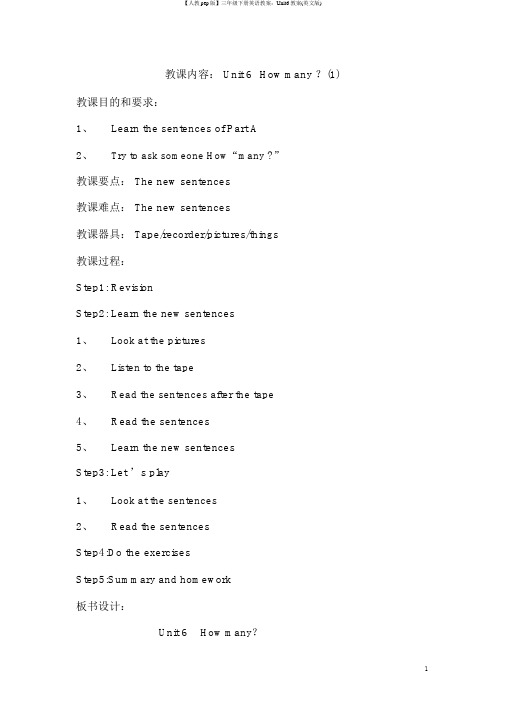人教版PEP小学英语三年级下册第六单元教案
- 格式:ppt
- 大小:1.41 MB
- 文档页数:10

Unit 6: How many (教学设计)教材情况本文档为人教PEP版英语三年级下册第6单元教学设计。
本单元主要讲解英语中的数字1-100,并且学习如何用英语表达和询问数量。
该单元共包括4个部分:1)数字1-10;2)数字11-20;3)数字21-100;4)询问和回答数量。
教学目标1.学会数字1-100的表达;2.熟练掌握用汉语问英语数字,用英语回答数字的表达方法;3.能在生活中运用数字进行简单的交流。
教学准备1.制作数字卡片;2.打印练习纸。
教学流程1. Warm-up (5分钟)使用数字卡片,让学生使用手中的数字卡片念出卡片上的数字。
教师提问一些问题,如:•How many fingers do you have?•How many toy cars do you have?•How many brothers and sisters do you have? 等等2. Presentation (15分钟)1.教师使用电脑或者手写数字1-10,拉上幕布。
教师依次展示数字卡片,让学生念出来,并且教师可以反复展示数字卡片,加深学生的记忆。
2.教师展示数字11-20的表达方法,例如11是“eleven”,让学生念出来,然后逐一展示数字卡片。
3.教师展示数字21-100的表达方法,例如21是“twenty-one”,让学生念出来,然后逐一展示数字卡片。
3. Practice (20分钟)1.用数字卡片提问和回答关于数字的问题。
例如:•How many toy cars do you have?•I have ten toy cars.2.教师将不同数字卡片洗在一起,让学生自己摸数字卡片,说出卡片上的数字。
3.学生之间可以互相出题目,找另一个同学回答。
4. Production (15分钟)教师设计小组活动,要求小组里的学生写出他们身边的事物数量,例如:“I have two pencils”,“I have three books”,并且汇总小组成员的数量,然后组长报道。

新人教PEP版三年级英语下册Unit 6 Period 3 Part A 优质教案一、教学目标1.学生能够听、说、认读单词:bear、elephant、monkey、tiger、panda、lion、giraffe、zebra、kangaroo 和 crocodile。
2.学生能够熟练运用句型“Let’s go and see…”,并能应答。
3.学生通过参与游戏的方式体验并练习听说读能力。
二、教学内容1.单词:bear、elephant、monkey、tiger、panda、lion、giraffe、zebra、kangaroo 和 crocodile。
2.句型:Let’s go and see…三、教学重难点1.学生能够熟练运用句型“Let’s go and see…”,并能应答。
2.学生能够听、说、认读单词,并进行相应的语境操练。
四、教学过程1. Introduction教师利用图片或实物进行出示,让学生看图猜单词,并利用已学短语和句子模仿说出相应单词。
2. Presentation① Watch and Listen教师出示动物图片,让学生一起观看并倾听录音,跟读并模仿发音。
② Point and Say教师出示各种动物图片,让学生模仿发音并跟读单词。
3. Practice利用“Let’s go and see…” 的问答句型进行游戏,游戏规则如下:•选取一名同学作为游戏主持人,大声说出“Let’s go and see…”加上一个动物名,比如“Let’s go and see the elephant”。
•其他所有的同学模仿主持人的话,并顺序说出自己想看的动物,比如“Let’s go and see the lion”,“Let’s go and see the giraffe”,“Let’s go and see the zebra”等等,直到游戏主持人说“stop”结束游戏。
4. Production设计课堂小游戏,学生通过小组竞赛形式,自由编排句子,进行比赛。

Unit6"WhatTimeIsIt?"Grade3,Book2,PEPEnglishTeachingObjectives:1.Studentswillbeabletoaskandanswerquestionsabouttimeusin g"Whattimeisit?"and"It'so'clock."2.Studentswillrecognizeandusethevocabularyrelatedtotime: "one,two,three,four,five,six,seven,eight,nine,ten,eleven,tw elve."3.Studentswillunderstandandusethephrase"Let's!"toinviteo therstodoactivitiesatspecifictimes.4.Studentswilldeveloptheabilitytotalkabouttheirdlyroutin esusingthetargetlanguage.TeachingAids:1.Coursebookandworkbook2.Blackboardandmarkers3.Flashcards4.AudioCD5.ProjectorandputerLessonPlan:1.Warm-up(10minutes)GreetingandReview:Teachergreetsthestudentsandreviewsthepreviousunit'svocabularyandsentences.Studentsanswerquestionsrelatedtothepreviousunit.Song:Teacherplaysthesong"WhatTimeIsIt,Mr.Wolf?"andstudentssin galong.Teacherasksstudentstoactouttheactionsastheysing.2.Presentation(15minutes)IntroductionofNewVocabulary:Teacherpresentsflashcardswiththenumbers1-12.Studentsrepeatthenumbersaftertheteacher.Teacherasksstudentstopointtothenumbersontheflashcardsand saythemoutloud.IntroductionofTargetSentences:Teacherwritesthesentence"Whattimeisit?"ontheboard.Teachermodelsthesentenceandstudentsrepeat.Teacherwrites"It'so'clock"ontheboardandmodelsthesentence withdifferenttimes,studentsrepeat.Role-play:Teacheractsasastudentandasks"Whattimeisit?"totheclass.Studentsanswer"It'so'clock."Teacherchangesthetimeandstudentscontinuetoanswer.3.Practice(20minutes)FlashcardGame:Teacherholdsupaflashcardwithatimewrittenonit.Studentsquicklysay"It'so'clock."Teachergivespointstothestudentswhoanswercorrectly.PrWork:Studentsworkinprs.Onestudentasks"Whattimeisit?"andtheotherstudentanswers"I t'so'clock."Studentsswitchrolesandcontinuetheactivity.GroupActivity:Studentsformgroupsoffour.Eachgroupmembertakesturnsaskingandanswering"Whattimeisit "and"It'so'clock."Teacherobservesandprovidesfeedback.4.Production(15minutes)Role-play:Studentsworkinprs.Onestudentpretendstobeaclockandtheotherstudentasks"Whatt imeisit?"andanswers"It'so'clock."Studentsswitchrolesandcontinuetheactivity.ClassDiscussion:Teacherasksstudentstosharetheirdlyroutinesusingthetargetlanguage.Studentssaysentenceslike"Igetupat7o'clock"or"Igotoschool at8o'clock."5.SummaryandHomework(10minutes)Summary:Teacherreviewsthenewvocabularyandsentenceswiththeclass.Studentssummarizewhattheylearnedintheirownwords.Homework:Studentspleteworkbookexercisesrelatedtotheunit.Studentspracticethetargetlanguagewiththeirfamiliesathome .Reflection:Thislessonwasdesignedtoengagestudentsinlearningabouttime usinginteractiveactivitiesandrole-playing.Thewarm-upsonghel pedtosetapositivetoneforthelesson.Thepresentationandpractic eactivitiesallowedstudentstobeefamiliarwiththenewvocabulary andsentences.Theproductionactivitiesprovidedstudentswiththe opportunitytousethetargetlanguageinreal-lifesituations.Over all,thelessonwassuccessfulinachievingtheteachingobjectives. Feedbackfromthestudentswaspositive,andtheywereeagertocontin uelearningabouttimeinfuturelessons.重难点补充:Teacher:"OK,class.Let'spracticeaskingandansweringaboutth etime.I'llstart.Whattimeisit?"Student1:"It'soneo'clock."Teacher:"Great!Nowyoutry.Whattimeisit?"Student2:"It'stwoo'clock."通过这样的对话,教师可以逐一让学生练习,确保每个学生都能正确地使用时间表达法。

PEP人教版小学英语三年级下册Unit6Howmany复习课教学设计Unit 6 How many Review教学设计一、整体设计思路本课是三年级下册Unit 6 How many Review的内容,本节课以“mindmap”作为教学媒介,通过任务设置,从单词到对话再到阅读,层层递进,引领学生如何用思维导图理清思路,归纳知识点,提升能力。
本课有效引领学生明白“知识是什么?(What?——关于生活中的数字)、怎样研究?(How?——思维导图,概括总结)以及研究价值?(Why?——掌握正确的研究策略,提高研究效率,发现生活中的数学)”,把学科教学和价值教育完美结合。
二、教学背景分析1.内容分析:PEP《小学英语》三年级下册Unit6的话题是“howmany”,通过思维导图、游戏、练等方式复数字,并且能在情景中运用XXX? I see…;How many … do you have? I have…等句型表达看见和拥有物品的数量。
在研究本课之前,学生已经研究了关于“1-10,水果,动物,文具”等词汇,因此,本课研究时应设计活动,激活学生元认知,滚动知识,以帮助学生建构知识体系,再在此基础上,导入新课,活动知识。
另外,本课的重点句型是询问数量How many的句型回答。
本课的话题是“Number”,教师通过去公园的主线,创设情景。
首先是通过Let’s say的方式,复、汇总重点词汇。
再通过去公园撕车牌,让学生理解数字并找出规律;通过听力写出数字,巩固听的能力;通过阅读,具体了解物品的数量,用思维导图对语篇进行概括,并在此基础上进行说的练。
最后,认识生活中的数字,还原生活的本色。
本课还结合单元目标,挖掘人文价值因素,发现生活中的数学,对学生如何有效研究,提高研究效率给予指导。
2.学情分析本节课的授课对象是小学三年级的学生,他们对英语有浓厚的兴趣,活泼乐学;本课的主题是“number”,在上学期已经研究1-10的表达,这个单元在原来的基础上研究11-20,在设计时考虑到这一情况,对所学内容进行滚动、联系、拓展。

人教版小学三年级英语第六单元教案(小编整理)第一篇:人教版小学三年级英语第六单元教案UNIT 6——Happy Birthday!第一课时学习者分析:对于1——10中的几个数字,平时在日常生活中,教师的口令中略有耳闻,但是说的水平参差不齐。
对于三年级的学生,一节课学10个数字确实有一定难度,因此在本课设计了较多形式活泼,灵活多样的练习。
单元目标:Let’s learn: 1——10数字英语表达。
课前准备:模型生日蛋糕;做数字头饰教学过程:Activity 1Mini task 1: Listen to the song 《Ten Little Candles》(教师边唱边用手势提示数字)Mini task2: Listen and watchT: I’m……;This is ……;(T introduce myself and the Ss)What’s your name? My name is ……Mini task3: Pairwork(Guessing Game? Yes/ No.(设计意图:遵循语言学从输入到输出的过程,从听歌曲初步感知,教师利用头饰数字进一步呈现,学生初步尝试说。
)Activity2Mini task1: Let’s do(Listen to the tape;Listen to the teacher) Mini task2: Find your neighbour.Mini task3: Let’s count from1——10.Mini task4: Byebye Game.(师擦掉一张卡片,生说Byebye!)(设计意图:玩中学,学中玩,循序渐进,阶梯式巩固。
)第二课时学习者分析:This is ……句型及Let’s eat.Great.Thank you.已学过。
学习目标:1、掌握句型:How old are you?2、A:Let’s talk.教学过程:Acitivy1: RevisionMini task1: Listen to the song 《Ten Little Cadles》(给学生一个初步印象)。

教课内容: Unit 6 How many ?(1)教课目的和要求:1、Learn the sentences of Part A2、Try to ask someone How“many ?”教课要点: The new sentences教课难点: The new sentences教课器具: Tape/recorder/pictures/things教课过程:Step1: RevisionStep2: Learn the new sentences1、Look at the pictures2、Listen to the tape3、Read the sentences after the tape4、Read the sentences5、Learn the new sentencesStep3: Let ’s play1、Look at the sentences2、Read the sentencesStep4:Do the exercisesStep5:Summary and homework板书设计:Unit 6How many?How many kites can you see?I can see 12.作业部署:1、Listen to the tape2、Read the sentences教课后记:教课内容: Unit 6 How many? (2)教课目的和要求:1、Let ’s learn thenumbers2、Try to listen and do3、Say out the numbers教课要点: The numbers教课难点: Say out the numbers教课器具: Tape/recorder/pictures/things教课过程:Step1: RevisionAsk and answerStep2: Learn the numbers1、Look at the pictures2、Find out the numbers3、Say out the numbers4、Listen to the tape5、Read the words after the recording6、Read and say the numbers7、Look and sayStep3: Let ’s do1、Look at the pictures2、Look at the numbers3、Listen to the tape4、Listen and doStep4:Summary and homework板书设计:Unit 6How many?How many cats can you see?I can see 10.作业部署:1、Listen to the tape2、Read the numbers教课后记:教课内容: Unit 6 How many ?(3)教课目的和要求:1、Learn the song2、Learn the sentences of Part B教课要点: The sentences教课难点: The sentences教课器具: Tape/recorder/pictures/things教课过程:Step1: Revision1、Say out the numbers2、Let ’s paintStep2: Let’ s sing1、Try to understand the meaning of the song2、Listen to the recording3、Sing after the tapeStep3: Let ’s talk1、Ask and answer2、Listen to the recording3、Try to understand the dialogue4、Read the dialogue5、Act the dialogue outStep4:Summary and homework板:Unit 6How many?Eleven twelve thirteen ⋯作部署:1、Listen to the recorder2、Read the sentences3、Draw a picture.教课后:教课内容: Unit 6 How many ?(4)教课目和要求:1、Learn the sentences2、Learn the numbers教课要点: The new words教课点: The new words教课器具: Tape/recorder/pictures/things教课程:Step1: RevisionStep2: Learn the new words of numbers1、Look at the numbers2、Learn the new numbers3、Listen to the recording4、Read the words5、Say out the numbersStep3: Let ’s do1、Look at the pictures2、Listen and doStep4:Exercises1、活着手册2、Look and sayStep5:Summary and homework板书设计:Unit 6How many?Jeep jump key kangaroo 作业部署:1、Listen to the tape2、Read the words.教课后记:教课内容: Unit 6 How many ?(5)教课目的和要求:1、Let ’s check2、Let ’s chant3、Story time教课要点: Let ’s check/ Let’s chant/ Story time 教课难点: Let ’s check教课器具: Tape/recorder/pictures教课过程:Step1: Let ’s check1、Listen to the tape2、Finish the exercises3、Check the answersStep2: Let’ s chant1、Look at the pictures2、Find out the numbers3、Listen to the tape4、Read the sentences after the recording5、Read the sentences togetherStep3: Story time1、Look at the pictures2、Listen to the recorder3、Try to understand the meaning of the story4、Read the sentences after the recording5、Read the sentencesStep4:Summary and homework板书设计:Unit 6 How many?How many crayons do you have?Guess!!!作业部署:1、Listen to the tape2、Read the sentences教课后记:教课内容: Unit 3 How many ?(6)教课目的和要求:1、To know the culture2、Learn the song3、Finish the exercises教课要点: The exercises教课难点: The exercises教课器具: Tape/recorder教课过程:Step1: To know the culture1、Look at the flags2、Say out the numbers of the flags Step2: Let’ s sing1、Look at the words of the songs2、Listen to the tape3、Read the words4、Sing the songStep3: Finish the exercises1、Listening work2、活着手册Step4:Summary and homework板书设计:Unit 6 How many?Lion milk mouse nest作业部署:3、Listen to the tape4、Finish the sentences教课后记:。
人教PEP版英语三年级下册第六单元时教案教学目标1.通过本次课程,学生能够正确地识别名词并准确表达。
2.学生能够用简单的句子问候和回答。
3.学生能够用英语表达身体部位。
教学重点1.身体部位的表达。
2.问候和回答的表达。
教学难点1.对身体部位的表达。
2.区分名词和动词的使用。
教学准备1.PPT课件。
2.小黑板和粉笔。
3.掌握英语语音和语调。
教学过程Step 1: 导入新课1.与学生们互动问候,询问学生们身体状况。
“Good morning, children! How are you today? Are you feeling well?”2.引入新课。
“Today, we are going to learn about body parts. Do you know what body parts mean?”Step 2: 呈现词汇1.展示图片和单词卡,让学生们认识身体部位。
(老师展示图片):“This is a body. We have arms, legs, eyes, ears, mouth, nose, and head on our body.”2.练习词汇。
(老师拿出单词卡):“Let’s practice the words. What do you call this?”(学生回答):“Arm.”(老师展示图片):“Yes, you are right. What about this one?”(学生回答):“Leg.”再继续进行,直到学生们认识所有部位。
Step 3: 课文演练1.学生跟随老师脚步学习课文。
“Hello, I’m Amy. What’s your name?” “Hi, I’m Tim. Nice to meet you.” “How are you?” “I’m fine, thank you.”2.老师分组,让学生进行问候练习。
Step 4: 总结与评价1.总结所学到的内容。
Unit6 How many?一、单元教学分析:本单元围绕“数字”这-话题展开。
教学的重点是通过教学有关数字的词汇和句型.能询问看到物品的数量,及询问别人拥有物品的数量并能够做出相应的回答等。
“数字”是个比较灵活的话题,与学生的生活和学习实际联系紧密。
在教学时,可以与颜色、水果、动物、文具等内容相结合。
同时,“数字”这一话题学生有过接触,在三上已经学习了1-10的基数词。
在教学11-20时,教师可以让学生发现和积累其中的规律。
另外,教材中各部分情境图展示了不同的语用环境,如在公园里、在赛场上等,在有趣的语境和情境中呈现本单元要学习的核心词汇和句型。
所以在教学时可以灵活多样地运用“教材情境图”和相应的音视频来呈现和操练新授内容,帮助学生感知词汇和句型的语义及语用情境。
在前几个单元学习的基础上,学生对字母a e,i,o, u的语音教学形式已经比较熟悉,教师可以借助前几个单元的词汇来复习巩固字母在单词中短音的发音规律,从“音”人手,帮助学生初步运用语音知识来提升单词的认读和识记成效。
C部分的小故事有机地整合和拓展了主要的词汇和句型,有趣幽默的故事情节引人人胜,在阅读理解的基础上,可以鼓励有能力的孩子进行表演或给故事配音。
二、单元教学目标:1、知识与能力目标句型(1)能够听懂、会说句型:How many ... do you see? I see .... How many ... do you have? Ihave .... Wow, so beautiful! Open it and see.(2)能够在图片、实物或情境的帮助下运用以下句型:How many ... do you see? s.询问看到物品的数量并做回答。
(3)能够在图片、实物或情境的帮助下运用以下句型:How many ... do you have? I have ...(4)询问或谈论拥有的物品数量,并能够根据实际情况做出恰当的回答。
1.掌握句型:How many…do you see?I see….2.通过情景对话,让学生能灵活运用核心句型来交流看到的物品数量。
学习核心句型:How many…do you see?I see…名词复数的读音。
课件水果图片(一)热身(Warm up):游戏:考眼力。
教师伸出一个手指一闪而过,询问学生:How many fingers do you see? 引出新句型并复习数字1到10。
教师问了两三个问题后可以请一个学生上讲台做“小老师”,与全班一起玩这个游戏,然后同桌之间轮流发问。
(二)新课呈现(Presentation):1.教师呈现对话情景图,引导学生看图谈论图片,滚动复习前面学过的颜色和动物单词,引出数字eleven, twelve并教读,注意twelve的-ve的发音。
2.播放对话录音,回答问题:How many kites do they see?3.学生打开课本听对话,教师对语言点进行讲解,(How many+名词复数)。
4.学生跟录音朗读对话,然后进行角色扮演。
(三)巩固与拓展(Consolidation and extension):1.Find and count.教师讲清规则,学生A询问How many…do you see?学生B根据图片回答I see…教师首先和一个学生示范,再组织两人对话活动。
2.让学生观察教室里的东西,并让学生运用本课所学的语言点进行对话练习,如:How many windows do you see? How many chairs doyou see?(四)家庭作业(Homework):1.听录音,仿读会话。
2.把课文中的对话,读给家长听。
本节课通过数风筝的情景让学生感知句型How many…do you see? I see…的语义及语用情境,热身用一个游戏开始,可能是因为学生对数字已经遗忘的原因,所以表现不是很积极,没有达到预期的效果,学习单词后,我进行了听、说、演环节的训练,然后自然引到拓展部分进行学习。
小学英语PEP人教版三年级下册《Unit6 At the zoo》教案一. 教材分析《PEP人教版小学英语三年级下册Unit6 At the zoo》主要介绍了动物和动物园的相关词汇和句型。
通过本单元的学习,学生能够掌握表示动物的词汇,如:tiger, panda, elephant, giraffe等,以及表示数量和特征的词汇,如:one, two, three, four, five, six, big, small等。
同时,学生还能学会用英语描述动物的外貌和特征,如:It’s a tiger. It’s big.二. 学情分析三年级的学生已经掌握了基本的英语语音、词汇和简单的句子结构,具备一定的听、说、读、写能力。
但是,对于一些复杂的动物特征描述和数量表达,学生可能还有一定的困难。
因此,在教学过程中,教师需要关注学生的个体差异,针对不同水平的学生给予适当的指导和帮助。
三. 教学目标1.知识目标:学生能够掌握表示动物的词汇,如:tiger, panda,elephant, giraffe等,以及表示数量和特征的词汇,如:one, two, three, four,five, six, big, small等。
学生能够用英语简单描述动物的外貌和特征。
2.能力目标:学生能够听懂、会说、会读、会写本单元的核心词汇和句型,能够在实际情景中运用所学知识进行交流。
3.情感目标:培养学生对动物的关爱和保护意识,提高学生学习英语的兴趣。
四. 教学重难点1.重点:动物词汇的掌握和运用,如:tiger, panda, elephant, giraffe等。
2.难点:表示数量和特征的词汇的运用,如:one, two, three, four, five,six, big, small等,以及动物特征的描述。
五. 教学方法1.情境教学法:通过设置动物园的情境,让学生在实际情景中学习和运用动物词汇和句型。
2.游戏教学法:通过动物卡片、捉迷藏等游戏活动,激发学生的学习兴趣,巩固所学知识。